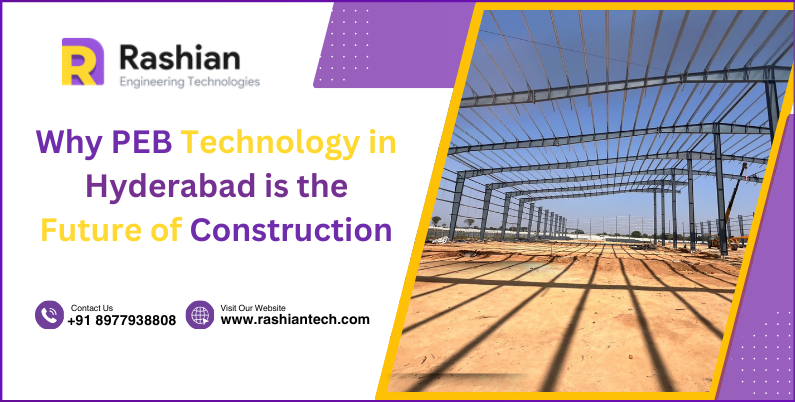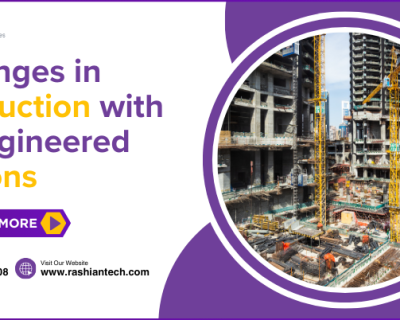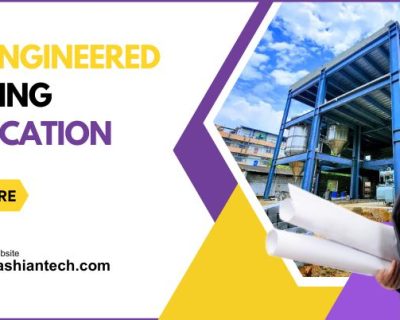Blog

Why PEB Technology in Hyderabad is the Future of Construction
Introduction to PEB Technologies
Pre-Engineered Buildings (PEB) technology is revolutionizing the construction industry by providing faster, cost-effective, and durable building solutions. In Hyderabad, where rapid urbanization and industrialization demand innovative construction methods, PEB technologies are becoming increasingly popular. The growing preference for these structures in industrial, commercial, and residential sectors highlights their potential to shape the future of construction.
What is PEB Technology?
PEB technology involves the fabrication of structural components in a factory, which are then transported to the construction site for assembly. These buildings use steel frames, roofing sheets, wall panels, and insulation materials, making them strong, lightweight, and efficient. The pre-engineered approach reduces construction time significantly compared to conventional methods.
Key Features of PEB Technologies:
- Prefabricated Components – Designed and manufactured off-site for quick assembly.
- Lightweight and Durable – High-strength steel components ensure longevity and resilience.
- Eco-Friendly Construction – Reduces waste and promotes sustainability.
- Cost-Efficient – Lower material and labor costs due to faster installation.
- Customizable Designs – Tailored solutions for different industries.
The Growth of PEB Technologies in Hyderabad
Hyderabad, a booming metropolis with expanding industrial and commercial sectors, is witnessing a surge in PEB construction. From warehouses and factories to shopping malls and office spaces, PEB technology is being widely adopted. Factors like infrastructure development, government initiatives, and increased investor interest contribute to its growing demand.
Why Hyderabad is Adopting PEB Technologies?
- Industrial Expansion: The presence of IT parks, pharmaceutical companies, and logistics hubs requires quick and scalable construction solutions.
- Urbanization: Rising demand for commercial spaces and residential buildings is fueling the need for faster construction.
- Government Support: Policies promoting infrastructure growth encourage the use of modern building techniques like PEB.
- Cost and Time Efficiency: PEB structures reduce construction time, helping businesses become operational sooner.
Advantages of PEB Technology Over Conventional Construction
- Faster Construction
Traditional construction methods can take months or even years to complete. PEB technology, however, significantly cuts down this timeframe. Since the components are pre-fabricated and simply need to be assembled on-site, project timelines are reduced by 40%–50%.
- Cost-Effectiveness
PEB structures require less material and labor, resulting in lower overall costs. The reduced construction time also means lower labor expenses and quicker project completion, making it a budget-friendly option for businesses and investors.
- High Durability and Low Maintenance
PEB buildings are designed to withstand harsh environmental conditions, including heavy rainfall, high temperatures, and seismic activity. Their robust steel structures ensure longevity, while the need for maintenance is minimal compared to traditional buildings.
- Energy Efficiency and Sustainability
PEB technology supports sustainable construction through:
- Reduced Waste: Prefabrication minimizes on-site material wastage.
- Recyclable Materials: Most steel components can be recycled, reducing environmental impact.
- Thermal Insulation: PEB buildings can be equipped with insulation materials to enhance energy efficiency, lowering heating and cooling costs.
Flexible and Customizable Designs
PEB structures can be tailored to suit specific project requirements. Whether it’s a warehouse, industrial facility, retail store, or commercial building, the design flexibility allows businesses to optimize space utilization effectively.
Applications of PEB Technologies in Hyderabad
PEB technology is widely used across various sectors in Hyderabad, demonstrating its versatility and efficiency.
- Industrial and Warehouse Buildings
Industries and logistics companies benefit greatly from PEB structures due to their quick setup and large, unobstructed interiors. Many manufacturing plants and storage facilities in Hyderabad have already adopted this technology.
- Commercial Buildings
Shopping malls, retail spaces, and office complexes are leveraging PEB technology for its cost-effectiveness and modern architectural appeal.
- Residential Housing
Although PEB is primarily used in commercial and industrial sectors, its application in residential housing is growing. Prefabricated homes offer quick construction and energy efficiency, making them an attractive option for modern housing.
- Infrastructure Projects
Government infrastructure projects, such as metro stations, airports, and sports complexes, are increasingly incorporating PEB technology to meet construction deadlines and budget constraints.
Challenges and Solutions in PEB Adoption
Challenges:
- Limited Awareness – Many builders and developers are still unfamiliar with the benefits of PEB technology.
- Initial Investment Costs – While PEB is cost-effective in the long run, the initial investment can be higher than conventional methods.
- Skilled Workforce – Specialized skills are required for the design and assembly of PEB structures.
Solutions:
- Awareness Campaigns – Educating stakeholders about the benefits and long-term savings of PEB technology.
- Government Incentives – Offering subsidies and tax benefits to encourage PEB adoption.
- Workforce Training Programs – Developing training centers to equip laborers with PEB construction skills.
Future of PEB Technologies in Hyderabad
Given the increasing demand for sustainable and cost-effective construction methods, PEB technology is poised to dominate the construction landscape in Hyderabad. With advancements in design, materials, and manufacturing, PEB structures will continue to evolve, offering even greater efficiency and aesthetic appeal.
Upcoming Trends in PEB Technology:
- Integration with Smart Technologies – Incorporating IoT and automation for better building management.
- Use of Green Materials – Enhancing sustainability through eco-friendly construction materials.
- Hybrid Construction Models – Combining PEB with traditional construction for diverse applications.
Conclusion
PEB technologies are transforming the construction industry in Hyderabad, offering a faster, cost-effective, and sustainable alternative to conventional building methods. As industries and infrastructure projects continue to grow, the adoption of PEB will play a crucial role in shaping the city’s architectural future. With the right policies, investments, and awareness, Hyderabad can emerge as a hub for innovative construction solutions driven by PEB technology.
By leveraging the benefits of PEB technologies, businesses, developers, and government agencies can ensure efficient and resilient infrastructure for the future.
FAQs
- What is the lifespan of a PEB structure?
PEB structures typically last for 50 years or more with proper maintenance, thanks to their high-quality steel components.
- Can PEB buildings withstand earthquakes?
Yes, PEB structures are designed to be earthquake-resistant by incorporating flexible and durable materials that absorb seismic shocks.
- Is PEB technology suitable for multi-story buildings?
Yes, PEB technology can be used for multi-story buildings, including commercial complexes, office spaces, and hotels.
- Are PEB structures fire-resistant?
PEB buildings can be equipped with fire-resistant coatings and materials to enhance their fire safety properties.
- How customizable are PEB designs?
PEB structures are highly customizable, allowing modifications in size, shape, color, and layout based on specific project requirements.
- How does PEB compare to RCC construction?
PEB construction is faster, more cost-effective, and lightweight compared to traditional RCC (Reinforced Cement Concrete) construction, which takes longer and involves higher labor costs.
- Can PEB structures be relocated?
Yes, one of the key advantages of PEB buildings is that they can be dismantled and relocated if required.
- What are the maintenance requirements for PEB buildings?
PEB buildings require minimal maintenance, with periodic inspections for corrosion, repainting, and structural integrity checks ensuring longevity.




